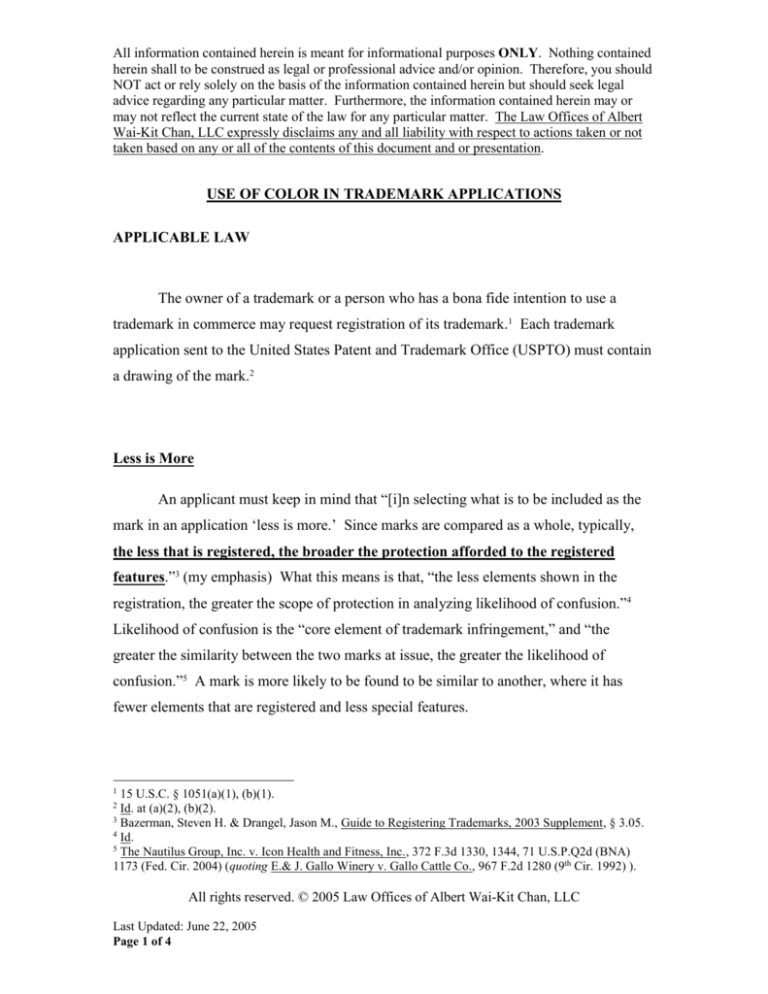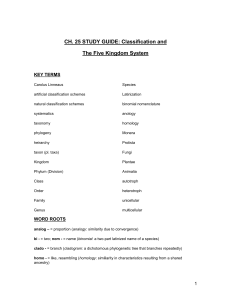
All information contained herein is meant for informational purposes ONLY. Nothing contained
herein shall to be construed as legal or professional advice and/or opinion. Therefore, you should
NOT act or rely solely on the basis of the information contained herein but should seek legal
advice regarding any particular matter. Furthermore, the information contained herein may or
may not reflect the current state of the law for any particular matter. The Law Offices of Albert
Wai-Kit Chan, LLC expressly disclaims any and all liability with respect to actions taken or not
taken based on any or all of the contents of this document and or presentation.
USE OF COLOR IN TRADEMARK APPLICATIONS
APPLICABLE LAW
The owner of a trademark or a person who has a bona fide intention to use a
trademark in commerce may request registration of its trademark.1 Each trademark
application sent to the United States Patent and Trademark Office (USPTO) must contain
a drawing of the mark.2
Less is More
An applicant must keep in mind that “[i]n selecting what is to be included as the
mark in an application ‘less is more.’ Since marks are compared as a whole, typically,
the less that is registered, the broader the protection afforded to the registered
features.”3 (my emphasis) What this means is that, “the less elements shown in the
registration, the greater the scope of protection in analyzing likelihood of confusion.”4
Likelihood of confusion is the “core element of trademark infringement,” and “the
greater the similarity between the two marks at issue, the greater the likelihood of
confusion.”5 A mark is more likely to be found to be similar to another, where it has
fewer elements that are registered and less special features.
1
15 U.S.C. § 1051(a)(1), (b)(1).
Id. at (a)(2), (b)(2).
3
Bazerman, Steven H. & Drangel, Jason M., Guide to Registering Trademarks, 2003 Supplement, § 3.05.
4
Id.
5
The Nautilus Group, Inc. v. Icon Health and Fitness, Inc., 372 F.3d 1330, 1344, 71 U.S.P.Q2d (BNA)
1173 (Fed. Cir. 2004) (quoting E.& J. Gallo Winery v. Gallo Cattle Co., 967 F.2d 1280 (9th Cir. 1992) ).
2
All rights reserved. © 2005 Law Offices of Albert Wai-Kit Chan, LLC
Last Updated: June 22, 2005
Page 1 of 4
All information contained herein is meant for informational purposes ONLY. Nothing contained
herein shall to be construed as legal or professional advice and/or opinion. Therefore, you should
NOT act or rely solely on the basis of the information contained herein but should seek legal
advice regarding any particular matter. Furthermore, the information contained herein may or
may not reflect the current state of the law for any particular matter. The Law Offices of Albert
Wai-Kit Chan, LLC expressly disclaims any and all liability with respect to actions taken or not
taken based on any or all of the contents of this document and or presentation.
In order to extend the amount of protection a trademark owner may try to obtain
protection for a word mark and a design mark. A trademark owner who owns separate
registrations for a word mark and a design mark (ordinarily used as a composite mark)
will have greater protection against another’s use of a mark substantially similar to either
the design or word portion of the composite mark.6
If the applicant only wants to register a word, letter or numeral, or any
combination thereof, not depicted in special form, the drawing may consists of the mark
in standard characters. A single registration of this type covers the mark in all printing
styles, forms, or colors in which it may appear, and there is ordinarily no need to file
additional applications to register the same word or letter merely because the type style or
form of display is changed. It is thus advantageous to submit drawings to the USPTO
“showing the mark in plain letters, without design elements or a special type style, in
order to support standard character drawing.”7
On the other hand, when a term is registered in a distinctive form other than typed
capital letters, then additional applications are required to change the form.8
A case that illustrates how a mark, with no special form in it, is afforded broad
protection is Fossil, Inc. v. The Fossil Group.9 In this case, Fossil, Inc. opposed the
registration of the trademark THE FOSSIL GROUP. Here, the court stated that “because
opposer’s registrations of FOSSIL are in typed drawing form, this means that opposer’s
rights in the word mark FOSSIL are ‘not limited to the mark depicted in any special
6
Bazerman, Steven H. & Drangel, Jason M., Guide to Registering Trademarks, 2003 Supplement, § 3.05.
Gilson on Trademark Protection and Practice, Vol. 1, Chap. 3, 1-3 Establishing Trademark Rights 3.04.
8
Foremost Corp. of Am. v. Burdge and Housing, Inc., et al., 638 F. Supp. 496, 499 (D.N.M. 1986).
9
Fossil, Inc. v. The Fossil Group, 1998 TTAB Lexis 388, 49 USPQ2d (BNA) 1451 (TTAB 1998).
7
All rights reserved. © 2005 Law Offices of Albert Wai-Kit Chan, LLC
Last Updated: June 22, 2005
Page 2 of 4
All information contained herein is meant for informational purposes ONLY. Nothing contained
herein shall to be construed as legal or professional advice and/or opinion. Therefore, you should
NOT act or rely solely on the basis of the information contained herein but should seek legal
advice regarding any particular matter. Furthermore, the information contained herein may or
may not reflect the current state of the law for any particular matter. The Law Offices of Albert
Wai-Kit Chan, LLC expressly disclaims any and all liability with respect to actions taken or not
taken based on any or all of the contents of this document and or presentation.
form.’”10 Thus the court went on to say that “in any likelihood of confusion analysis, we
‘must consider all reasonable manners in which the word FOSSIL could be depicted.’”11
The court found that “the word THE has little source of identifying significance, and the
word GROUP has somewhat limited source identifying significance [and thus the court
found that] applicant’s mark and opposer’s mark FOSSIL are similar enough such that
their use on closely related goods (clocks and watches) is likely to result in confusion.”12
Color
In seeking protection of a mark, protection can then be obtained regardless of its
color. In fact, a “single registration of a word mark may cover all its different
appearances, potential as well as actual.” Courts have also found that an applicant can in
fact “obtain a single registration of a design mark covering all the different colors in
which it may appear, that is to say, not limited to a particular color.”13
A color, which is combined with words, designs, symbols or other arbitrary and
distinguishing matter, can be protected by trade dress law. Trade dress law protects the
total image of a product or package, including colors, designs, shapes, and texture if: 1) it
is inherently distinctive or has attained secondary meaning, 2) it is nonfunctional, and 3)
there is likelihood of confusion.14
10
Fossil, Inc. v. The Fossil Group, at 6 (quoting Phillips Petroleum v. C.J. Webb, 422 F.2d 1376, 170
USPQ 35, 36 (CCPA 1971) ).
11
Fossil, Inc. v. The Fossil Group, 1998 TTAB Lexis 388, 6, 49 USPQ2d (BNA) 1451 (TTAB 1998),
(quoting INB National Bank v. Metrohost, 22 USPQ2d 1585, 1588 (TTAB 1998).
12
Fossil, Inc. v. The Fossil Group, at 15.
13
In re Data Packaging Corp., 59 C.C.PA. 776, 779, 453 F.2d 1300, 1302 (1972).
14
Gilson on Trademark Protection and Practice Vol 1, Chap. 2, Trademark Subject Matter 2.11.
All rights reserved. © 2005 Law Offices of Albert Wai-Kit Chan, LLC
Last Updated: June 22, 2005
Page 3 of 4
All information contained herein is meant for informational purposes ONLY. Nothing contained
herein shall to be construed as legal or professional advice and/or opinion. Therefore, you should
NOT act or rely solely on the basis of the information contained herein but should seek legal
advice regarding any particular matter. Furthermore, the information contained herein may or
may not reflect the current state of the law for any particular matter. The Law Offices of Albert
Wai-Kit Chan, LLC expressly disclaims any and all liability with respect to actions taken or not
taken based on any or all of the contents of this document and or presentation.
RECOMMENDATIONS
When considering the use of color in registering a trademark, it is recommended
that the parties consider the following:
1) once you have decided and registered that one color, any changes may require
additional trademark filing;
2) although only one color was chosen, you may be able to protect all variations
of that one chosen color;
3) by choosing one color and sticking to it, you will be able to strengthen your
mark by fixing that color in consumers’ minds and associating it with your
service/product;
4) simple and plain type face registration for your mark may afford you more
protection; and
5) you have to decide whether your company’s “image” for now and the future
will be best represented by that one color.
All rights reserved. © 2005 Law Offices of Albert Wai-Kit Chan, LLC
Last Updated: June 22, 2005
Page 4 of 4









